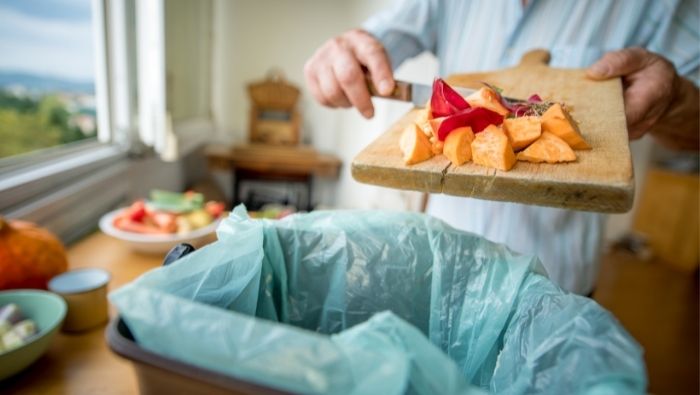Simple Steps to Eliminating Food Waste and Higher Food Bills
These simple steps can help you eliminate food waste so you can stop throwing your hard-earned cash in the trash.

Were your eyes bigger than your stomach? That’s what my dad used to say to my sister and me when half way through a plateful of food, our tummies were full and we couldn’t manage even one more bite.
We knew we shouldn’t waste food, but we’d simply overestimated our capacity.
As a nation, we seem to have the same problem. Some experts estimate that close to half of all food produced worldwide is wasted. Each year, as much as 30% of food is tossed in the US alone.
So what makes us so wasteful?
Overbuying Is a Primary Cause of Food Waste
We get into our beautiful, bedazzling grocery palaces and we do exactly what the grocery gurus have programmed us to do. We spend. We overspend. It all looks so good! And much of it is on sale! The more we buy, the more we save. Right?
And then we take it all home. Those two bags of spinach were a really good deal and loaded with nutrition, but it’s almost six o’clock and the kids are screaming and everyone’s famished so we order a pizza.
The next night little Janey has hockey practice and the twins have a sleep over so we open a can of soup. With one thing and another, it’s five days later before anyone thinks of the spinach, and it’s too late. It’s clumping together in a wilted and worrisome way and some of the leaves are moist and mushy. Yuck!
The cool new flavor of yogurt that we just had to try somehow found its way to the back of the fridge, where it was discovered a few weeks later, a day after its best before date. Oops!
And the donuts that were to be an after dinner treat? The first half of the box was great the first night. The second half would have been perfectly acceptable the second night, but someone forgot to re-wrap them and they went stale. Oh well.
Sign Up for Savings
Subscribe to get money-saving content by email that can help you stretch your dollars further.
Twice each week, you'll receive articles and tips that can help you free up and keep more of your hard-earned money, even on the tightest of budgets.
We respect your privacy. Unsubscribe at any time.
Be Careful When Buying in Bulk
Buying in bulk is a great idea, but we also need to consider how many meals that case of hamburger will cover or how many on the verge of overripe mangos our family can realistically consume.
Freezing extra meat is easy; freezing extra vegetables takes a little effort.
Will we find the time to make the effort?
Plan Ahead
Work out your menu for a week, and make a shopping list. Also, try not to shop when tired or hungry, which are prime settings for overspending and impulse purchases.
Watch those “best before” dates. And know what’s in your fridge.
Learn Proper Food Storage Practices
Wrap bread and baked goods well to keep them fresh but don’t choke the life out of produce with tight plastic wrap. It keeps the moisture in and condenses it into tiny drops of water that dampen and eventually decay the produce.
Don’t wash fruit and veggies until just before you use them. Chopping and dicing and even de-stemming gives microorganisms a place to grow.
Organize your menu to eat the most perishable produce first. Eat berries before root vegetables, fresh fruit before frozen, etc.
Know What Ethylene Does to Your Produce
Consider the ethylene, which is that colorless, odorless gaseous hormone that all fruits and veggies give off. Some species emit high levels. These include apples, apricots, avocados, unripe bananas, cantaloupe, figs, honeydews, nectarines, peaches, plums, and tomatoes.
Others are extra sensitive to the effects of ethylene. These include ripe bananas, broccoli, Brussels sprouts, cabbage, carrots, cauliflower, cucumbers, eggplant, kiwi, lettuce (and other leafy greens), parsley, peas, peppers, summer squash, sweet potatoes, and watermelon.
Use your fridge’s two crispers to keep the emitters away from the ethylene sensitive.
Use ethylene to your advantage. To hasten the ripening of a peach or a tomato, put it in a paper bag with a ripe banana.
Plan for Leftovers
Bread crusts can be made into crumbs, and stale cheese can be frozen and used in a sauce. A thimbleful of wine will jazz up a gravy. Throw ripe fruits into smoothies. Make your own stock with leftover meats and vegetables.
Instead of using a bit of parsley for a recipe and then letting the remaining damp stalks languish in plastic bags in the fridge, think about growing your own herbs. It’s cheaper, healthier, and definitely more aesthetically pleasing.
Make a weekly date to clean out the fridge.
When you shop, remember that a bulk bargain is not a bargain if half of it rots before you can eat it. And, try not to let your eyes be bigger than your family’s stomachs.
Reviewed May 2024
Popular Articles
On After50Finances.com
- 9 Things You Need to Do Before You Retire
- You Didn’t Save Enough for Retirement and You’re 55+
- When Empty Nesters Reorganize and Declutter Their Home
- Reinventing Your Career in Your 50s or 60s
- What Mature Homeowners Should Know about Reverse Mortgages
- 2 Reasons to Collect Social Security Benefits As Soon As Possible


